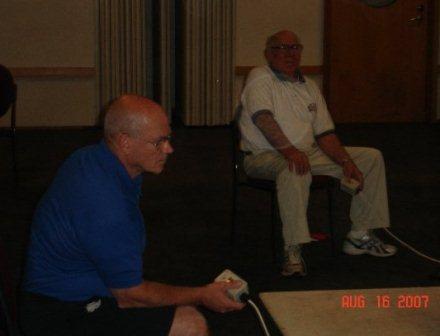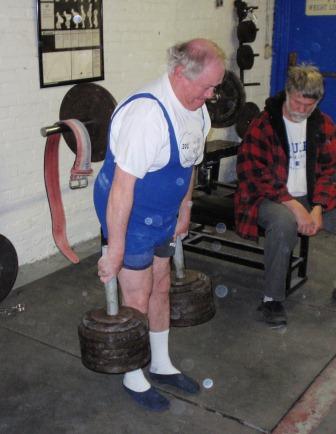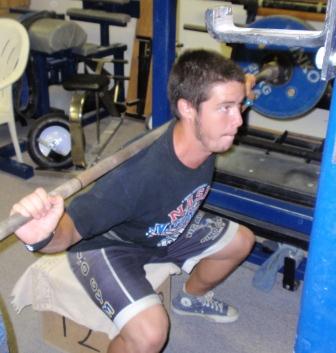Updated Rules Test
by Al Myers

USAWA President Denny Habecker (left) and the late Wilf Chapman (right) of Australia officiating at the 2007 IAWA World Championships in New Zealand.
I just want to announce that the USAWA Rules Test has been updated. The USAWA Official’s Director Joe Garcia and myself have made a few changes to the Open Book Rules Test that must be passed in order to become an USAWA Certified Official. Joe had identified some “bad questions” on the old exam and these questions have been changed or modified. Now I’m not saying we made the test easier – because a few new “hard” questions were added as well. From this point on, this new test must be the one taken. Don’t fill out and send in the old test! If you do, you will be asked to take this new one instead. So this is YOUR WARNING!!!!! Also, due to some rule changes in the past couple of years, the answers to some questions have changed. This new test is much improved, with very few “open ended” questions.
There are actually rules for the Rules Test. Since there are no questions covering these rules of the Rules Test in the Rules Test (wow, say that three times quick!), I’m going to go over them. This is taken from Section VII of the USAWA Rule Book as it applies to the Rules Test:
10. There will be two levels of classification for Certified USAWA officials.
- Level 1 Test Qualified – The official has passed the USAWA Rules Test.
- Level 1 Experience Qualified – The official has the experience of officiating in 25 or more competitions or events.
- Level 2 – The official has passed the USAWA Rules Test and has the experience of officiating in 25 or more competitions or events.
11. The USAWA Secretary will maintain a list of certified officials, their level of classification, and their active/inactive status. This list will be available to the membership.
12. The USAWA Rules Test will consist of 100 open book questions regarding rules within this rulebook. The test must be completed and returned to the Officials Director to be judged. There is no time limit in taking the test. To pass the test, an applicant must score over 90 percent. The Officials Director will inform you only of a pass or fail. You will not be told the questions you missed. If you fail, you may retake the test as many times as you like. Once an applicant has passed the test, the Officials Director will inform the USAWA Secretary to include you on the list of Certified USAWA Officials.
13. Once an official has passed the Rules Test, the Officials Director will issue an Officials card that will be valid for 3 years from the date the official passed the test. Level 1 Test Qualified Officials will be required to retake the Rules Test after 3 years to maintain Certified Official Status. Level 1 Experience Qualified Officials will receive an Officials card that is valid for 3 years and will be automatically renewed unless the official has been inactive as an official during the previous three year period, in which a new Officials Card will not be issued unless the individual makes a written request to the Officials Director. Level 2 Officials are exempt from recertification, and are issued a lifetime officials card.
14. An individual must make a written request to the Officials Director in order to apply for Level 1 Experience Qualified Certified Status and provide proof that the individual has the 25 competition experience requirement. This also applies to an official who wants to change their level of certification from Level 1 Test Qualified to Level 2.
In a couple of years (2013) we will begin to have a few officials that will need to renew their certification. Joe and I have discussed this, and we have decided that we will work up a new test in a year from now. This way those re-certifying will have a new and different test to take. I’m sure some questions will remain the same or just be changed slightly. I KNOW myself (and Joe) will hear some complaining and bellyaching when this happens, but THAT IS JUST THE WAY IT IS in order to have a good officials program. Our officials program already lets the “experienced” officials “off the hook” when it comes to taking the Rules Test. That is why there is that “25 event” loophole in the rules now. My opinion is that EVERYONE should be taking the test and this is why – we have over 200 official lifts in the USAWA, and the rules are being changed and amended every year now, plus new lifts are being added. Even the experienced officials have to “stay on top of things” in order to be a good official. The main reason of the Rules Test is to insure that the officials are familiar with the current USAWA Rulebook. All the questions on the test can be “looked up” and answered, since it is an open book exam. This process FORCES someone to at least know where to look for the answers to judging questions or where the individual lifts rules are located in the Rulebook. Since I’m on a “soapbox” right now, let me tell you about another gripe I have with officiating (besides the USAWA and IAWA(UK) rules differences). First of all, wrong calls on lifts will always be made by officials. I even see it watching NFL games with instant replay, and these guys are paid “big bucks” to be professional officials. Making a bad call doesn’t bother me – and I believe the officiating is as good in the USAWA as it ever has been. Judgement calls are judgement calls – and everyone sees things differently. What bothers me is when “experienced officials” really don’t even KNOW THE RULES. That is inexcusable. All you have to do is have a rulebook and READ THE RULE of the upcoming lift before sitting in the chair. I watch outstanding seasoned officials like Denny Habecker and this never happens to him, and this is why. He is always carrying his Rulebook with him when officiating and reads over the rules for the upcoming lift (which he probably knows like the knurling on his favorite bar) just TO BE SURE he hasn’t forgot something. That’s what it takes to be an outstanding official!!!
This new Rules Test is located on the website under “USAWA Information – Officials & Rules Test” .


